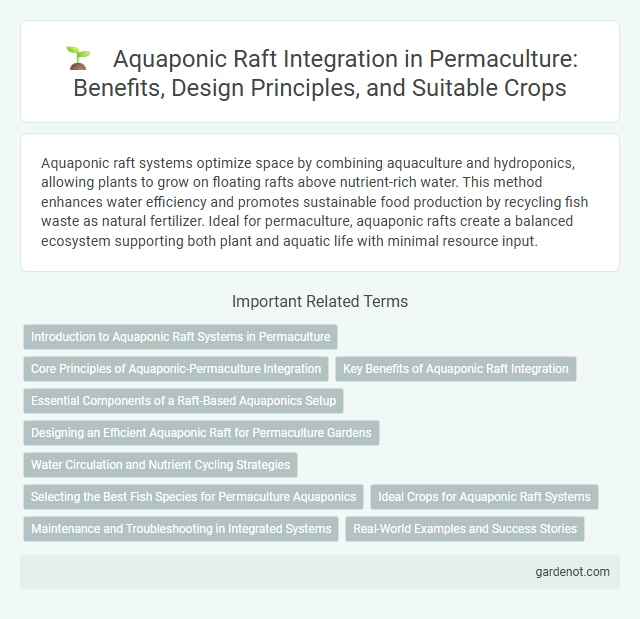Aquaponic raft systems optimize space by combining aquaculture and hydroponics, allowing plants to grow on floating rafts above nutrient-rich water. This method enhances water efficiency and promotes sustainable food production by recycling fish waste as natural fertilizer. Ideal for permaculture, aquaponic rafts create a balanced ecosystem supporting both plant and aquatic life with minimal resource input.
Introduction to Aquaponic Raft Systems in Permaculture
Aquaponic raft systems integrate fish farming and hydroponic plant cultivation, creating a sustainable, closed-loop ecosystem essential in permaculture design. In these systems, fish waste provides organic nutrients for plants growing on floating rafts, while plants purify the water, enhancing nutrient recycling and reducing environmental impact. This method maximizes space efficiency, water conservation, and nutrient cycling, making it a vital technique for sustainable food production in permaculture.
Core Principles of Aquaponic-Permaculture Integration
Aquaponic raft systems embody the core principles of aquaponic-permaculture integration by combining water-efficient aquaculture with sustainable plant cultivation, promoting nutrient cycling and resource reuse. These systems optimize space by supporting floating grow beds that host plants while fish waste provides natural fertilization, reducing the need for synthetic inputs. This integrated approach enhances ecosystem resilience, soil health, and biodiversity within permaculture designs.
Key Benefits of Aquaponic Raft Integration
Aquaponic raft systems optimize water efficiency by continuously recirculating nutrient-rich water, reducing waste and conserving resources. These systems enhance plant growth with stable nutrient delivery and oxygenation, resulting in higher yields compared to traditional soil methods. Integration of fish farming promotes a sustainable ecosystem, balancing nitrogen cycles and minimizing external inputs.
Essential Components of a Raft-Based Aquaponics Setup
A raft-based aquaponics setup requires key components including a floating raft, usually made from polystyrene, that supports plants while allowing roots to dangle into nutrient-rich water. A fish tank supplies nutrient-laden water through a pump system that circulates between the tank and grow beds, ensuring optimal oxygen levels and nutrient delivery. Biofilters and aerators are essential for maintaining water quality by converting fish waste into plant-available nutrients and increasing dissolved oxygen.
Designing an Efficient Aquaponic Raft for Permaculture Gardens
Designing an efficient aquaponic raft for permaculture gardens requires selecting durable, nutrient-rich growing media and integrating a stable flotation system to support plant growth. Optimizing water flow and oxygenation within the raft enhances fish and plant health, promoting a balanced ecosystem. Incorporating diverse compatible plant species maximizes nutrient uptake and sustains sustainable food production in permaculture systems.
Water Circulation and Nutrient Cycling Strategies
Aquaponic raft systems utilize continuous water circulation to maintain optimal oxygen levels and transport nutrients efficiently between the fish tanks and plant beds. The integration of biofilters decomposes fish waste into nitrates, facilitating nutrient cycling that supports plant growth while purifying water for fish health. Strategic water flow design ensures balanced nutrient distribution and prevents stagnation, enhancing system sustainability in permaculture practices.
Selecting the Best Fish Species for Permaculture Aquaponics
Choosing the best fish species for permaculture aquaponic raft systems depends on factors like temperature tolerance, growth rate, and nutrient output. Tilapia is a popular choice due to its hardiness, fast growth, and ability to thrive in varying water conditions, providing ample nutrients for plants. Other viable species include catfish and trout, which adapt well to specific climates and contribute valuable waste for plant nutrition, optimizing system sustainability.
Ideal Crops for Aquaponic Raft Systems
Leafy greens such as lettuce, spinach, and kale thrive exceptionally well in aquaponic raft systems due to their lightweight structure and rapid growth cycle. Herbs like basil, mint, and cilantro also perform efficiently, benefiting from the constant nutrient-rich water flow. These crops optimize nutrient uptake and maximize yield in controlled aquaponic environments.
Maintenance and Troubleshooting in Integrated Systems
Aquaponic raft systems require regular monitoring of water quality parameters such as pH, ammonia, nitrite, and nitrate levels to maintain optimal conditions for fish and plants. Routine checks and cleaning of pumps, air stones, and filters prevent clogging and system failures, ensuring balanced nutrient cycling. Troubleshooting common issues like algae overgrowth, root rot, and oxygen depletion involves adjusting water flow, improving aeration, and managing fish stocking densities to sustain system health.
Real-World Examples and Success Stories
Aquaponic raft systems have transformed urban agriculture by combining fish farming with hydroponic plant cultivation, as demonstrated by the Growing Power project in Milwaukee, which produces over 22,000 pounds of food annually using sustainable aquaponic methods. In Singapore, Sky Greens pioneered vertical aquaponic rafts to optimize limited land space, resulting in a 30% increase in crop yield compared to traditional soil farming. These success stories highlight aquaponic raft technology's capability to enhance food security while reducing water usage by up to 90%.
Aquaponic raft Infographic

 gardenot.com
gardenot.com